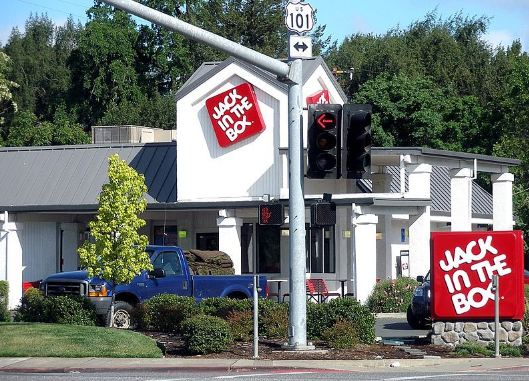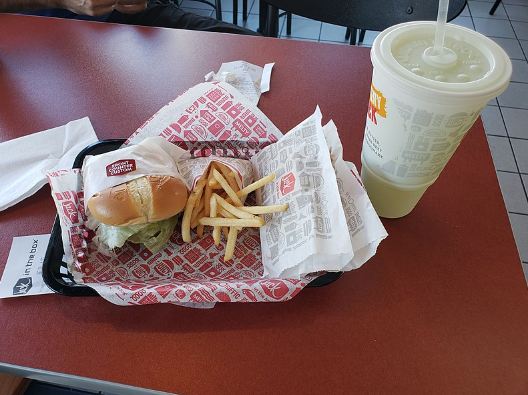Unlike other American fast-food chains that have gone national and global, Jack in the Box remains a regional fast-food chain. Because it is mainly concentrated on the West Coast and the southwestern areas of the country, you have probably never eaten at one. But at least you are familiar with it, thanks to its bizarre (and sometimes controversial) television commercials.
Besides being a regional chain, there are other factors that make Jack in the Box unique to other fast-food restaurants. While it wasn’t the first drive-through restaurant, Jack in the Box was the first to use a two-way intercom at its drive-through. Although Jack in the Box serves burgers, its menu is also diverse, making the chain a standout in the American fast-food landscape.
The opening of the “Box”
Founder and owner Robert Oscar Peterson opened the first Jack in the Box restaurant in San Diego, California, in 1951. But it wasn’t even his first restaurant venture. He had already owned several restaurants before, including Topsy’s Drive-In, also located in San Diego, in 1941.
Drive-through concepts were not new any longer. However, Peterson enhanced this system to his restaurant by adding an intercom service to simplify the process of ordering and to allow faster food preparation process. The intercom had a two-way speaker system, allowing the customer and the restaurant crew member to talk to each other remotely. He also added a clown face on top of the roof, greeting roadside motorists who were the restaurant’s primary customers. The two-way intercom system allowed faster and more efficient service than the conventional drive-up window. It would be adopted by other Jack in the Box branches and also by other chains.
In 1960 – nine years after launching Jack in the Box – Peterson established Foodmaker as the chain’s holding company. At the time, all of its 180 locations were owned by Foodmaker and concentrated mainly in California and the Southwest. This ensured that the quality of food and service was strictly controlled to the highest standards.
From struggles to success
In 1968, Peterson sold Foodmaker to Ralston Purina Company, which later opened its doors to franchising, particularly in the West Coast and Midwestern locations. Its television commercials in the 1970s became popular. But in the latter part of the decade, its sales were slumping, causing the chain to halt their expansion plans on the East Coast. By the end of the decade, Jack in the Box was sold in increasing numbers.
To shift its focus to more adult food, Jack in the Box decided to take its marketing strategy to a more radical direction. In 1980, the restaurant chain scrapped the clown – which had been its mascot for almost 30 years – by actually blowing it in its latest television commercials with the tagline, “The food is better at the Box.”
Apart from adopting bizarre marketing campaigns, Foodmaker also revamped Jack in the Box’s menu beyond mere burgers and fries. It stopped competing with McDonald’s by forsaking its former customer base of families and children and introduced a higher-quality and more upscale menu targeted for older, more affluent “yuppie” customers. The change proved to be a hit.
From then on, Jack in the Box’s menu became a lot more diverse, offering salads, finger foods, chicken sandwiches, and Seasoned Curly Fries.
While Jack in the Box was doing generally well for Ralston Purina, in 1985 the company decided to sell the chain to a group of investors, including Foodmaker’s management team. Two years later, Foodmaker went public, and its initial public offering (IPO) proved to be a success that led to more new branches. By the late 1980s, there had been over 800 Jack in the Box restaurants.
Foodmaker gave up all of its other businesses and focused solely on Jack in the Box. In 2004, it opened JBX Grill, a line of fast-casual restaurants offering higher-quality cafe-style food. Two of Jack in the Box branches in San Diego tested the JBX Grill concept, and soon a few more test locations followed. However, the concept proved unsuccessful, causing the converted restaurants to go back to their original fast-food business.
Jack in the Box currently offers a variety of food items including burgers, egg rolls, burritos, mozzarella cheese sticks, stuffed jalapenos, chicken tenders, bacon cheddar potato wedges, churros, cheesecakes, all-day breakfast, salads, sandwiches, and many others. However, the chain’s most popular items are their crunchy hard-shell tacos, which it has been selling since the 1950s. Jack in the Box also allows their customers to customize their meals.
Jack in the Box has over 2,200 quick-serve restaurants in the U.S. mainland (particularly the West Coast, southwestern, and Midwestern regions) and Guam.



